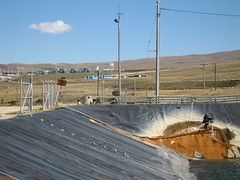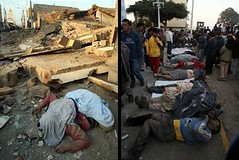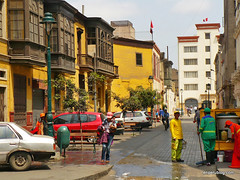As part of the restoration work of recent years a section of the southern river bank of the Rimac, where the railway to Huancayo runs, was turned into a small park with fountains for people to come and walk through. During this work the forgotten colonial walls of Lima were rediscovered and preserved as an attraction within the small park.
Category: "Travel and Places"
Fishing on the Peruvian coast
I’ve seen coastal scenes in the UK, in France and in Chile, all of which, although mostly the same, I feel give some insight into the country in which they are located.
I am familiar with seeing fishing boats coming ashore with their catch, birds flocking around harbours looking for dropped fish and all the sites you would expect on the coast. I’ve seen these scenes every year in my life and was interested to see the Peruvian version – and I did on my recent trip to the beach.
Cerro Azul – Lima’s Beaches
South of the city of Lima are dozens of beaches on an irregular desert coastline that are visited by thousands of Limeños in the summer months. The first set of beaches outside of the city are in the Lurín valley and continue down to the famous beaches at Asia and then towards the edge of the Lima region. Bays, sandy beaches, peninsulas, cliffs, and rocks, the coast spans hundreds of kilometres and has it all.
Chinchero
Chinchero is a bustling market town on Sunday and a sleepy Andean village the rest of the week.
Other than the market, and the stunning views of the grassy plains and icy mountains that surround the area, the main attraction is a colonial adobe church built on the foundations of an Inca palace for late-15th-century Tupac Yupanki, in what was once an Inca city.
Inca Stone Masonry
The quality of the Incas stone work is what many people notice when visiting their ruins, or even just walking through the streets of Cusco. But how did they manage to carve so accurately, to a degree we can only just achieve today with sophisticated technology such as lasers? How could they cut the stone bricks and place them so tightly together that you couldn’t slide a sheet of paper between them – that not even air can blow through?
From the works of Hiram Bingham to many recent studies, several hypothesis have been put forward. But could the answer be not so different from our modern lasers?
Intihuatana
The Intihuatana (or Intiwatana) is referred to as the Hitching Post of the Sun – as that is what many experts think its function was, to symbolically tie the sun the the earth at the two equinoxes so it could not move further in the sky. At the time of an equinox the perfectly carved 14 degree angled stone has no shadow, yet does have one all day and all year round when not an equinox.
Sacred Rocks
In front of Huayna Picchu is a massive slab of rock that is said to take the shape of the mountains behind it. This rock, like all large rocks, was sacred to the Incas.
A major part of Inca beliefs were that such rocks store vast sums of energy that can be transferred to people. All things in nature were similarly thought to be special in some way, from water to the Sun.
Of course, the biggest rocks that exist are the Andes themselves, and this is why the Incas built everything at the tops of them, the pinnacles of the stores of energy.
Hiking Huayna Picchu
As if climbing from Aguas Calientes to Machu Picchu, then from Machu Picchu to the Sun Gate on a mostly empty stomach was not enough, I was determined to hike to the top of Huayna Picchu.
Machu Picchu
Machu Picchu means “old peak” in the Inca language of Quechua, as Huayna Picchu the thin point mountain at the other side of the ruins means “young peak”. These are not Inca names, we don’t know what they called the mountain, nor their city, rather the name was given by a geographer and cartographer working to document the region…
Free Custom Tours of Machu Picchu
Walking back from the Sun Gate, back to where we arrived at the end of our long climb from the valley below, we found ourselves at the Watchman’s hut. From here we got our first proper postcard view of the ruins.
By now, thousands of day-trippers had arrived on the trains from Cusco, and any chance of a good photo was ruined. But there is a massive benefit to having to cope with all these people – free custom tours of Machu Picchu!
The Fog at the Sun Gate
We arrived to Machu Picchu to see it shrouded in fog. Already exhausted from our walk from the valley below, we climbed down onto some Inca farming terraces, just below the famous Watchman’s Hut and sat down in the rain to rest. We could see next to nothing of the ruins, so we decided to take a walk in the direction of the Sun Gate, from where groups of hikers were arriving from their days of hiking the Inca Trail.
The Long Climb to Machu Picchu
To walk to Machu Picchu from Aguas Calientes involves a steep continuous climb for an hour and a half in the rain. You can take the US$12 bus instead for a five minute journey, but that’s more than what two hour-long bus rides in one of the most expensive cities in the world costs.
We set off early, just before 6am, minutes after dawn. This was 30 minutes later than planned, but we hoped to arrive no more than 30 minutes after the 6:30am opening time of the ruins. There were few other tourists awake, and the buses were just preparing for their day. It looked like we were going to be one of the first ones there. We set off from the town to the river, vaguely aware of where we were going.







![How to become an Olympian [Featured]](http://farm3.static.flickr.com/2696/4356910596_7d5da589e3_m.jpg)


![Andean women’s football championships [Featured]](http://farm4.static.flickr.com/3123/2686374230_4b1aac1b08_m.jpg)